
a web page by Don Roberson |
HERONS Ardeidae |
||||
|
||||
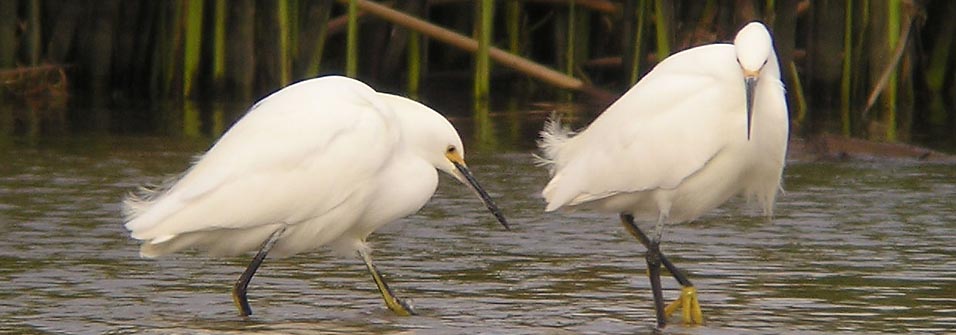 |
||||
Payne & Risley (1976) divided the family into four major subfamilies: the bitterns, the day-herons, the tiger-herons, and the night-herons. This division did not hold up under DNA analysis, but it was the traditional starting point. While day-herons and egrets around the world are easy to watch, tiger-herons and bitterns are mostly secretive and can be difficult to observe. I find it particularly fun to locate one of the really secretive ones — such as one of the small bitterns -- like this Schrenck's Bittern in a marsh in Manchuria, China (left). |
||||
 |
||||
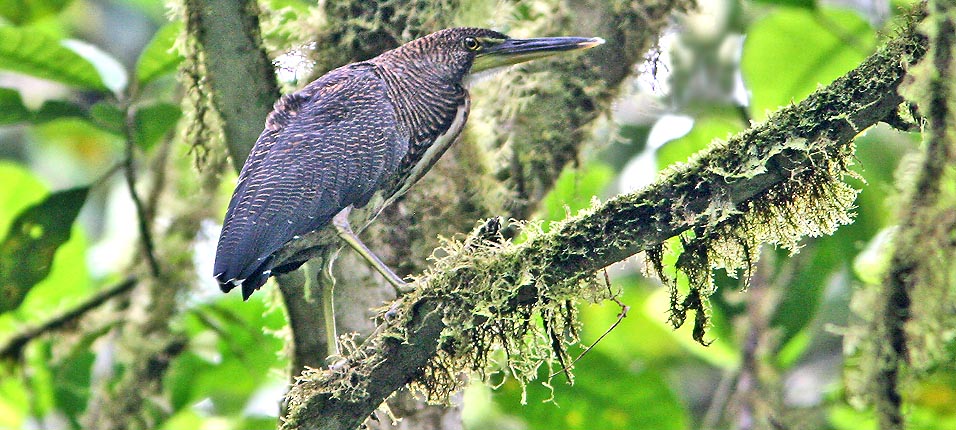 |
||||
There are two other relatives of tiger-herons in the Old World: Forest Bittern (or New Guinea Tiger-Heron) Zonerodius heliosylus, about which rather little is known, and the equally mysterious White-crested Bittern (or Tiger-Heron) Tigriornis leucolophus of deep forest in west and central Africa. |
||||
|
||||
 |
||||
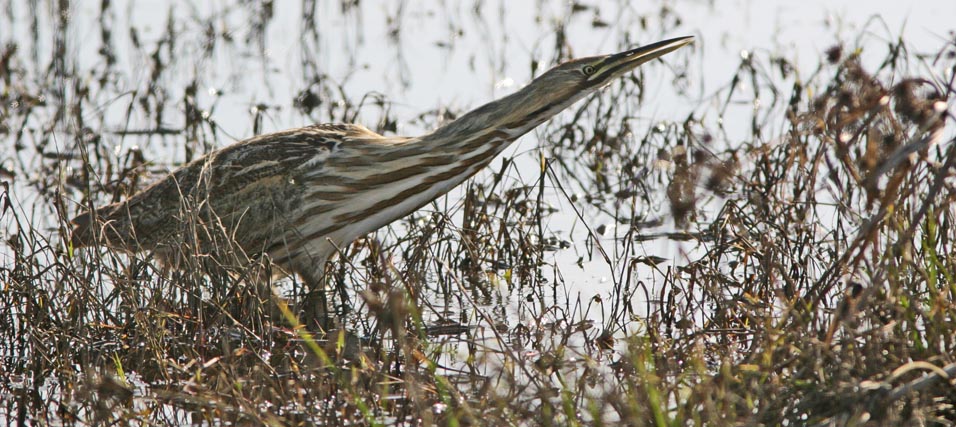 |
||||
|
||||
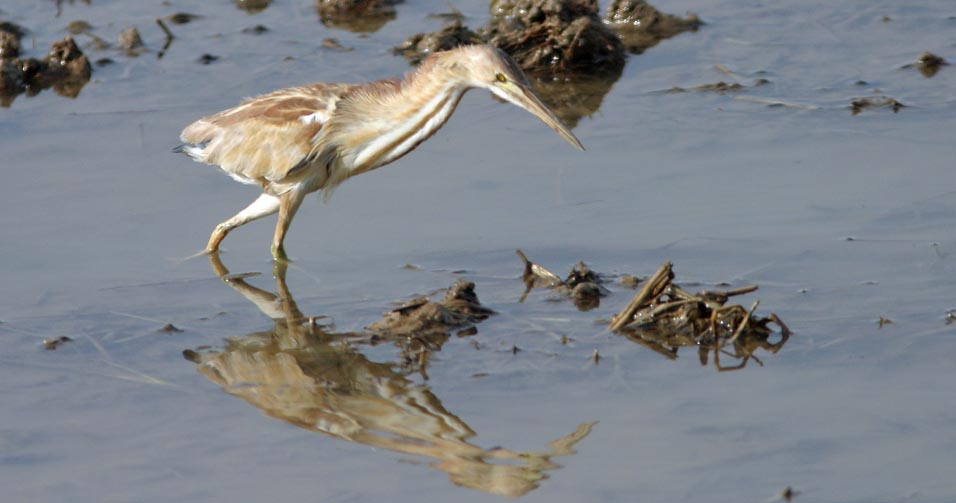 |
||||
|
||||
The replacement species in Australasia (and west to the Malay Archipelago) is Rufous Night-Heron (below left). These two are squabbling over a fish one of them has just caught. The other widespread New World species is Yellow-crowned Night-Heron (below right), occurring from the southern United States through Amazonia, and in the Galapagos Islands. |
||||
|
||||
This shot of Green Heron (near right) illustrates one feeding technique of the herons — the quiet stance on a limb over the water and then a quick jab as a small fish swims by. |
||||
Yet, when perched, much of that white is hidden, as on the Indian Pond-Heron (below) that has found a fine perch over a mucky Indian pond on a Sambar. |
||||
 |
||||
The final Ardeola heron is quite different — it is the little known, local and generally scarce Rufous-bellied Heron (right). It is usually found alone, walking slowly along quiet streams, in seasonally flooded grasslands, or stands of papyrus in central and eastern Africa. |
||||
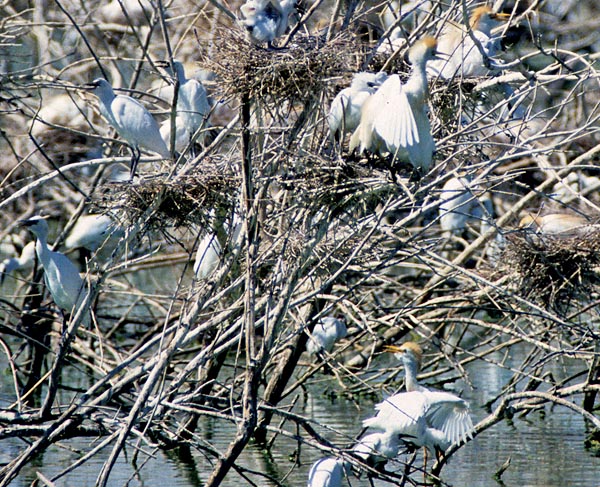 The champion commensal heron is Cattle Egret (left,
in a dense breeding colony). Cattle Egret evolved following large herds
of mammals in the African plains — antelope, gnus, elephants, hippos,
cape buffalos — and has easily adapted to foraging around domestic
cattle. They snatch up insects and other prey flushed up by the moving
herds. Cattle Egrets became the consummate world traveler. They spread
before recorded history to tropical Asia and Australasia, and were
adapted to spinning off vagrants flying far distances out to sea,
reaching the Seychelles in the Indian Ocean long enough ago to have
evolved their own subspecies there. It is 1780 miles from Africa to
South America, but with favorable northeast trade winds it would take
only 40 hours of flying time, and there are three mid-Atlantic islands
to stop at enroute (Hancock & Elliott 1978). The first known Cattle
Egret to reach South America was in 1880 and by 1937 they were nesting.
They then invaded North America via two routes (Central America and
across the Caribbean from Trinidad) during the 1940s & 1950s, and
by 1956 were scattered from Florida to Boston (Davis 1960). The first
one reached California in 1962. Today, huge colonies exist at the
Salton Sea (this photo). The champion commensal heron is Cattle Egret (left,
in a dense breeding colony). Cattle Egret evolved following large herds
of mammals in the African plains — antelope, gnus, elephants, hippos,
cape buffalos — and has easily adapted to foraging around domestic
cattle. They snatch up insects and other prey flushed up by the moving
herds. Cattle Egrets became the consummate world traveler. They spread
before recorded history to tropical Asia and Australasia, and were
adapted to spinning off vagrants flying far distances out to sea,
reaching the Seychelles in the Indian Ocean long enough ago to have
evolved their own subspecies there. It is 1780 miles from Africa to
South America, but with favorable northeast trade winds it would take
only 40 hours of flying time, and there are three mid-Atlantic islands
to stop at enroute (Hancock & Elliott 1978). The first known Cattle
Egret to reach South America was in 1880 and by 1937 they were nesting.
They then invaded North America via two routes (Central America and
across the Caribbean from Trinidad) during the 1940s & 1950s, and
by 1956 were scattered from Florida to Boston (Davis 1960). The first
one reached California in 1962. Today, huge colonies exist at the
Salton Sea (this photo). |
||||
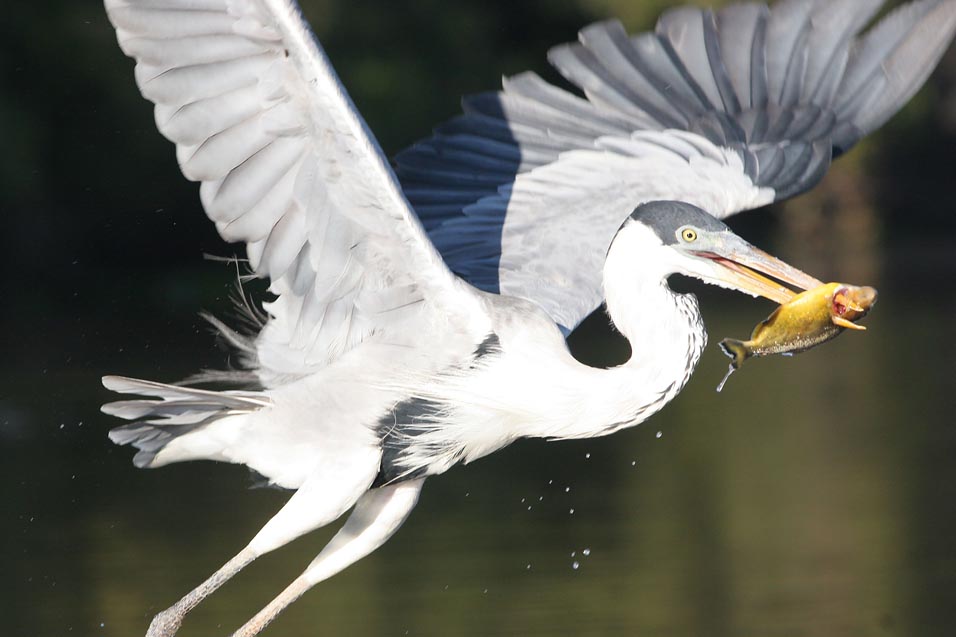 |
||||
Most of the herons can be divided up into Old World and New World species, and often there are close replacements in the two regions, such as the Great Blue Heron of the New World (pair at nest, right) which is closely related, and is very similar in appearance, to Gray (Grey) Heron A. cinerea of the Old World. A few species, however, are found in warmer climates around the world, and most stately may be the Great Egret (just below). There are some proposals to split it into three geographic species (New World, Old World, Australasia) but compelling evidence for the split is not yet available. The large white heron has been the symbol of the National Audubon Society for a hundred years, ever since that organization's early origins in fighting the egret plume trade in Florida (such plumes were once fashionable on women's hats). The Great Egret has an impressive bill for spearing fish, but it doesn't hold a candle to the dagger possessed by the Purple Heron (second row below) of the Old World tropics (Africa to se. Asia). These warm-climate species are often resident, although vagrants do move north into the northern hemisphere in our summer, bringing vagrants to Europe. |
||||
 |
||||
 |
||||
A very unique technique is used by the Black Heron of Africa and Madagascar, called "canopy feeding." Following an African Spoonbill Platalea alba, which is stirring up the mud, the Black Heron spreads its wings to create a shadow on the water, as if a protective log was above (below left). Small fish often gather in such shadows, but here they will be running to "shelter" which is their doom. Otherwise, Black Heron is just a very dark black heron on the muddy shore (below right). |
||||
|
||||
The other unique Neotropical day-heron is the exquisite Whistling Heron (below). It is one of the least aquatic of all herons, generally occurring in open, wet grasslands, and sometimes seasonally flooded woodlands. Its centers of occurrence are the Venezuelan llanos and the seasonal wetlands of southern Brazil and eastern Argentina. In flight, Whistling Herons give high frequency calls for which they are named. |
||||
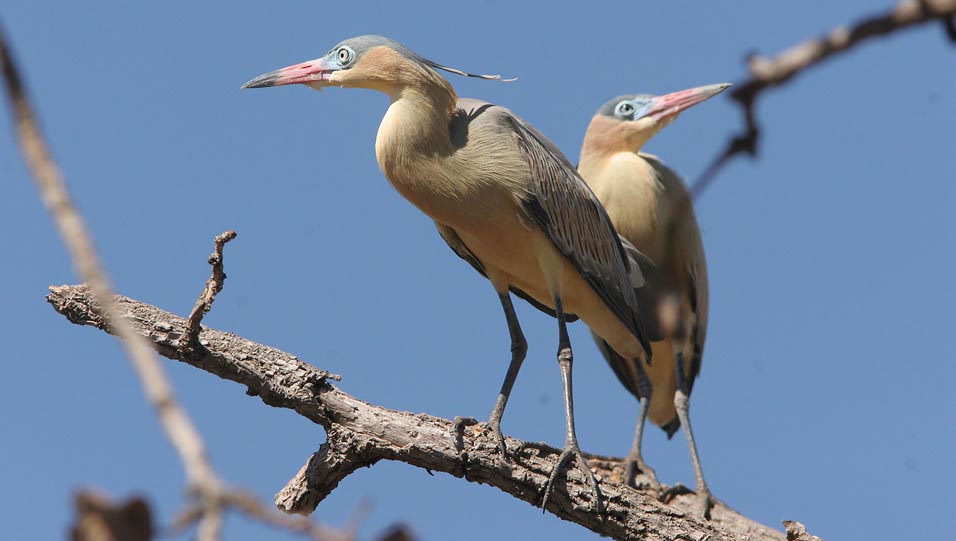 |
||||
We've barely mentioned the small egrets and reef-herons — some white, some dark — that occur in the tropics around the world. The western Pacific is particularly rich in these small egrets. This digiscoped shot, taken at high tide in the rain on Palawan, Philippines, has three Little Egrets and a slightly-larger Chinese Egret (below). Chinese Egret is an endangered species (only ~1000 pairs; Martínez-Vilata & Motis 1992), breeding very locally in eastern China and Korea, and wintering from the Philippines to the Greater Sundas. And we've barely touched on breeding and young. Here's a gaggle of three Great Blue Heron fledglings (below, plus an adult), not yet out of the nest in a Monterey pine, just a few blocks from my office in Monterey, California. Yes, herons are pretty cool. |
||||
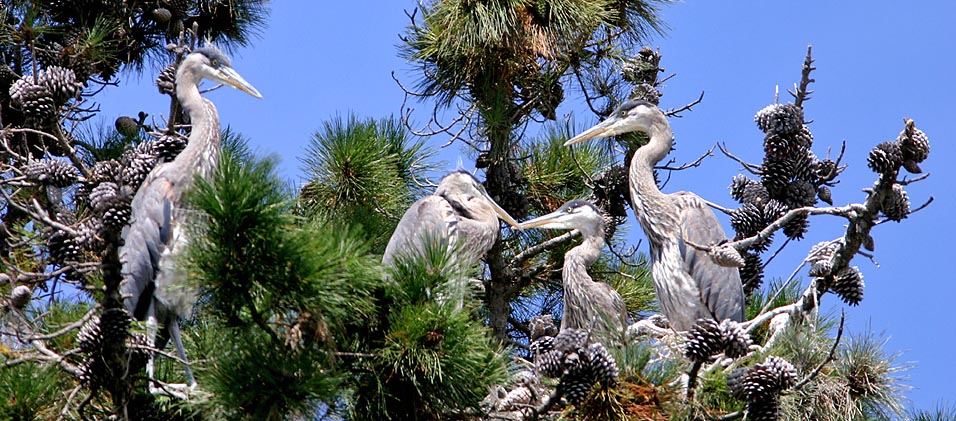 |
||||
Photos: The Snowy Egret Egretta thula duo were at Carmel R. mouth, California, USA, on 17 Jan 2005. The Schrenck's Bittern Ixobrychus eurhythmus was at Xinghai Nature Reserve, Jilin, China, on 13 June 2004. The pondful of egrets and storks was in the Brazilian Pantanal in July 2010. The Fasciated Tiger-Heron Tigrisoma fasciatum was along the Rio Pizote, Osa Peninsula, Costa Rica, on 26 Dec 2007. The Rufescent Tiger-Heron Tigrisoma lineatum was was in the Brazilian Pantanal on 24 July 2010. The Bare-throated Tiger-Heron Tigrisoma mexicanum was along the Estero San Cristobol, San Blas, Nayarit, Mexico, on 28 Feb 1987. Arthur Grosset photographed the Zigzag Heron Zebrilus undulatus at Rio Cristalino, Brazil, in Dec 2006. The Boat-billed Heron Cochlearius cochlearius was near Porto Jofre, Brazil, on 21 July 2010. The Agami Heron Agamia agami was a highlight of a dawn canoe ride on Cocachoca, Tambopata Nature Reserve, Peru, on 24 June 1987.The stalking American Bittern Botaurus lentiginosus was at the Yolo Bypass, California, on 6 Mar 2005, and the other was hiding in the reeds at Palo Alto baylands, San Mateo Co., California, on 1 Dec 1986. The Cinnamon Bittern Ixobrychus cinnamomeus and the Yellow Bittern I. sinensis were in rice paddies on Mindoro, Philippines, in Dec 2005. The Little Bittern I. minutus was in the Okavango delta, Botswana, on 23 July 2005. Greg W. Lasley photographed the Least Bittern I. exilis in Kennedy Co., Texas, on 20 June 2000. The landing Black-crowned Night-Heron Nycticorax nycticorax was at Crespi Pond, Pt. Pinos, California, on 10 Oct 2008. The squabbling Rufous Night-Herons N. caledonicus were at Dayla, Irian Jaya, Indonesia, on 9 Aug 1994.The Yellow-crowned Night-Heron Nyctanassa violacea was on the Estero San Cristobol, San Blas, Nayarit, Mexico, on 28 Feb 1987. The fishing Green Heron Butorides virescens was in Everglades National Park, Florida, in Jan 1999. The Striated Heron B. striatus was in the Brazilian Pantanal on 19 July 2010. The two shots of Squacco Heron Ardeola ralloides at in the Okavango delta, Botswana, in July 2005. The Sambar-riding Indian Pond-Heron A. grayii was at Ranthambhore, India, in March 2001. The Rufous-bellied Heron Ardeola rufiventris as in Tarangire NP, Tanzania, on 6 Aug 2002. The colony of Cattle Egret Bubulcus ibis were at Ramer Lake, Imperial Co., California, on 27 June 2003. The fish-stabbing Cocoi Heron Ardea cocoi was on Rio Clara, Brazilian Pantanal, on 20 July 2010. The nesting Great Blue Herons Ardea herodias and the breeding-plumed Great Egret Ardea alba was at Moss Landing harbor, Monterey Co., California, on 13 Feb 1996. The Purple Heron Ardea purpurea was at Ranthambhore, India, in March 2001. The adult Little Blue Heron Egretta caerulea was in Shark Valley, Everglades Nat'l Park, Florida, USA, in Jan 1999. The Black Heron Egretta ardesiaca was at Lake Jipe, Kenya, on 26 Nov 1981. The Capped Heron Piherodius pileatus was in the Brazilian Pantanal in July 2010, while the two Whistling Heron Syrigma sibilatrix were at Emas NP, Brazil, that same month. The horde of Pied Herons Ardea picata were at the Port Moresby wastewater ponds, Papua New Guinea, on 14 Oct 1983. The Chinese Egret Egretta eulophotes with Little Egrets E. garzetta was at Puerto Princessa, Palawan, in Dec 2005. The Black-headed Heron Ardea melanocephala was in Ngorongoro Crater, Tanzania, in Aug 2002. The nest with fledgling Great Blue Herons was in Monterey, California, on 25 June 2005. All photos © Don Roberson, except those attributed © Arthur Grosset and © Greg W. Lasley, and used with permission; all rights reserved. Family book: Rating
A nice introduction to the family is in Martínez-Vilata & Motis (1992), with an excellent collection of photos. Literature cited:
|
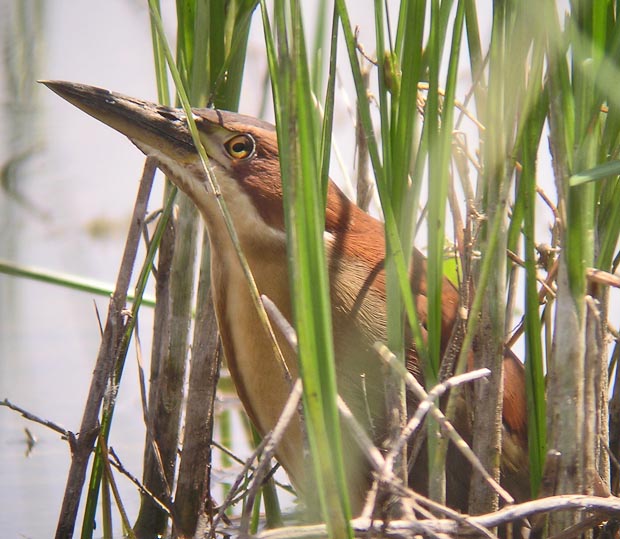 The
herons of the world are a large and interesting family with ancient
origins stretching back to the Lower Eocene some 55 million years ago
(Martínez-Vilata & Motis 1992). Most are associated with
water and are nicely adapted for preying on fish, frogs, and other
marsh denizens, like these two hunting Snowy Egret (above). Frequently, marshland scenes are full of herons and egrets (below; Pantanal pond dominated by many Great Egret, with some Jabiru and Wood Storks).
The
herons of the world are a large and interesting family with ancient
origins stretching back to the Lower Eocene some 55 million years ago
(Martínez-Vilata & Motis 1992). Most are associated with
water and are nicely adapted for preying on fish, frogs, and other
marsh denizens, like these two hunting Snowy Egret (above). Frequently, marshland scenes are full of herons and egrets (below; Pantanal pond dominated by many Great Egret, with some Jabiru and Wood Storks).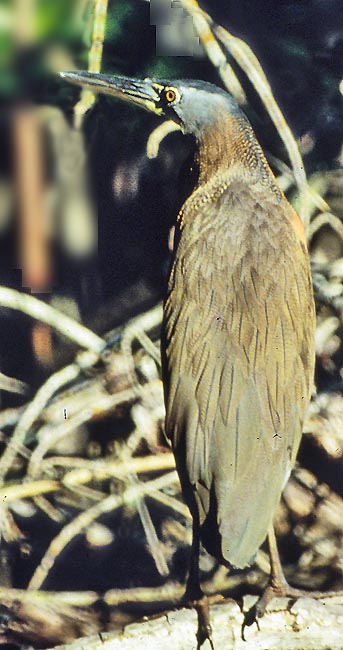
 Molecular
evidence has re-adjusted the relationships of herons (Sheldon 1987,
Sheldon et al. 2000, Cheng et al. 2003). The most ancient lineage
appears to be the tiger-herons. Fasciated Tiger-Heron
(above) occurs along foothill streams in wet, mossy forest from Costa
Rica to Argentina. It is secretive, may be partially nocturnal, and
normally forages alone. Rufescent Tiger-Heron (near
right) is widespread in the Neotropics. It frequents quiet backwaters
as well as the larger, more open marshes of the Pantanal or llanos. Bare-throated Tiger-Heron
(far right) is a secretive, and possibly partially nocturnal, denizen
of coastal esteros — freshwater, brackish, or salt water — in Central
America. Together they are the three tiger-herons of the New World.
Molecular
evidence has re-adjusted the relationships of herons (Sheldon 1987,
Sheldon et al. 2000, Cheng et al. 2003). The most ancient lineage
appears to be the tiger-herons. Fasciated Tiger-Heron
(above) occurs along foothill streams in wet, mossy forest from Costa
Rica to Argentina. It is secretive, may be partially nocturnal, and
normally forages alone. Rufescent Tiger-Heron (near
right) is widespread in the Neotropics. It frequents quiet backwaters
as well as the larger, more open marshes of the Pantanal or llanos. Bare-throated Tiger-Heron
(far right) is a secretive, and possibly partially nocturnal, denizen
of coastal esteros — freshwater, brackish, or salt water — in Central
America. Together they are the three tiger-herons of the New World. 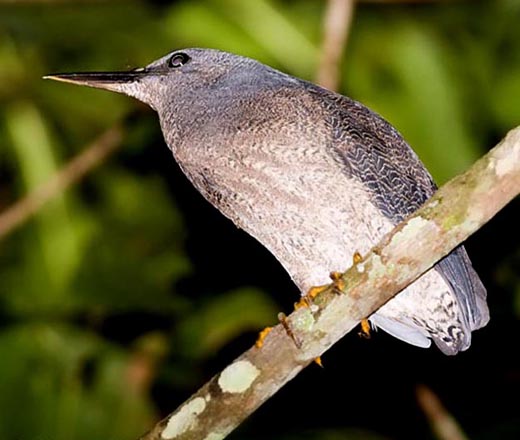
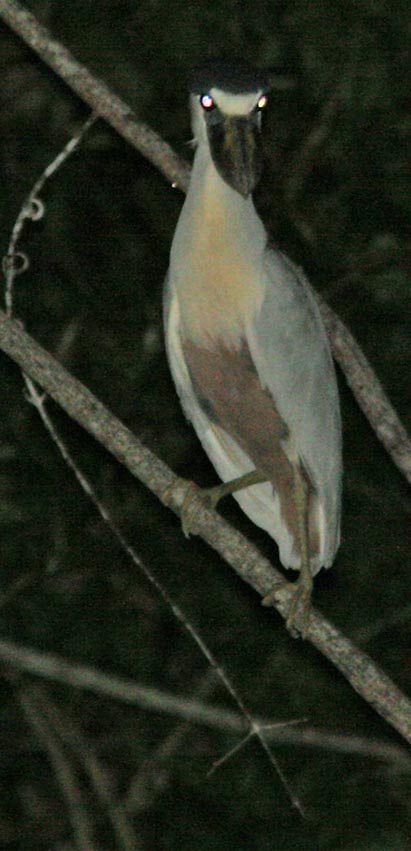
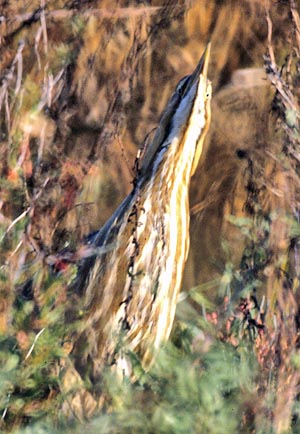 The bitterns are a secretive subgroup of herons that hide among reeds by holding still. The large bitterns, like American Bittern (above & left), are in genus Botaurus. There is a single Botaurus
on each continent. American Bittern, for example, breeds from Alaska to
Mexico. There are single species in South American and in Australasia,
but Great Bittern B. stellaris inhabits both Asia and Africa.
Each of these is a treat to find, as they are very adept at holding
still and 'disappearing' among the reeds in their striped plumage. They
can still have both eyes forward in this 'bittern' position (left).
The bitterns are a secretive subgroup of herons that hide among reeds by holding still. The large bitterns, like American Bittern (above & left), are in genus Botaurus. There is a single Botaurus
on each continent. American Bittern, for example, breeds from Alaska to
Mexico. There are single species in South American and in Australasia,
but Great Bittern B. stellaris inhabits both Asia and Africa.
Each of these is a treat to find, as they are very adept at holding
still and 'disappearing' among the reeds in their striped plumage. They
can still have both eyes forward in this 'bittern' position (left).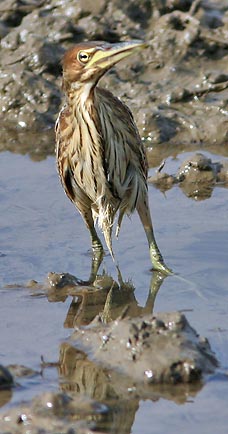
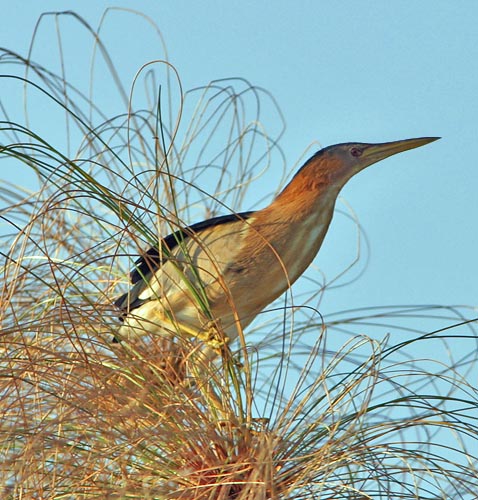
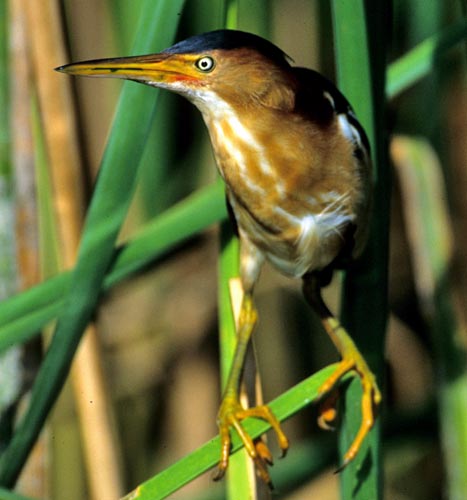
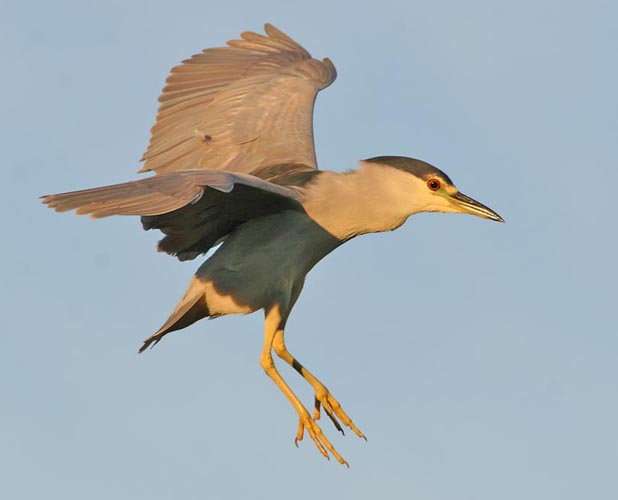 The
night-herons, with large eyes for feeding in the dark, is the next
subgroup. [Traditionally, the Boat-billed Heron of the Neotropics was
thought to be related, but the DNA evidence dispels that theory — it is
not closely related.] There are three genera of night-herons, but the
most widespread species — indeed, it is found around the world (except
Australasia) — is Black-crowned Night-Heron (left).
The
night-herons, with large eyes for feeding in the dark, is the next
subgroup. [Traditionally, the Boat-billed Heron of the Neotropics was
thought to be related, but the DNA evidence dispels that theory — it is
not closely related.] There are three genera of night-herons, but the
most widespread species — indeed, it is found around the world (except
Australasia) — is Black-crowned Night-Heron (left). 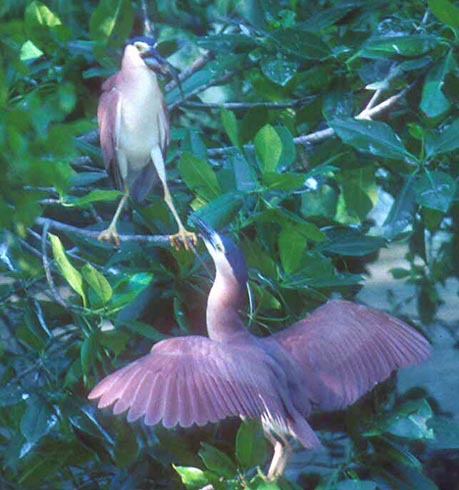
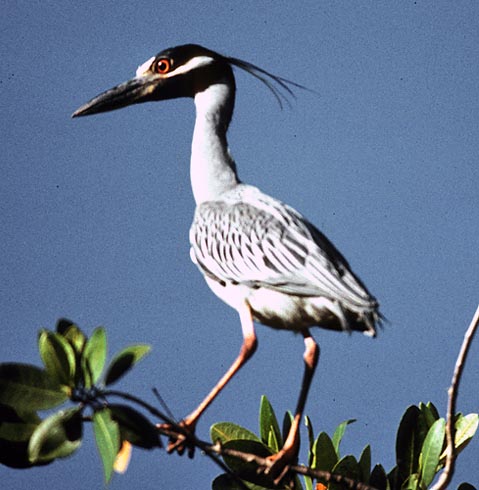
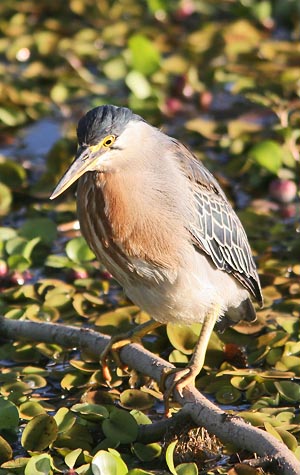
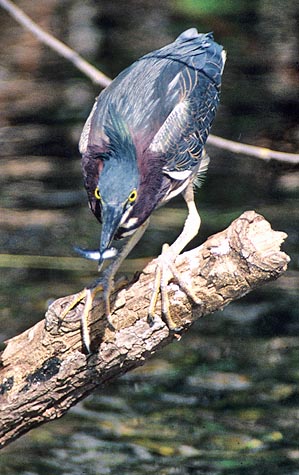 While
there is now general agreement on the subgroups of the heron family,
there is still disagreement about the number of species. A major bone
of contention is how to handle the genus Butorides, such as Green Heron (near right) and Striated Heron
(far right). I agree with the approach of Sibley & Monroe (1990)
and Clements (1991) to split this worldwide genus into at least two
species, but Hancock & Elliott (1978) and Martínez-Vilata
& Motis (1992) still lump them all together. In the two species
scenario, Green Heron is the Butorides of North and Central
America, with Striated Heron in South America and the Old World. A
third potential species is Galapagos (or Lava) Heron B. sundevalli.
While
there is now general agreement on the subgroups of the heron family,
there is still disagreement about the number of species. A major bone
of contention is how to handle the genus Butorides, such as Green Heron (near right) and Striated Heron
(far right). I agree with the approach of Sibley & Monroe (1990)
and Clements (1991) to split this worldwide genus into at least two
species, but Hancock & Elliott (1978) and Martínez-Vilata
& Motis (1992) still lump them all together. In the two species
scenario, Green Heron is the Butorides of North and Central
America, with Striated Heron in South America and the Old World. A
third potential species is Galapagos (or Lava) Heron B. sundevalli. 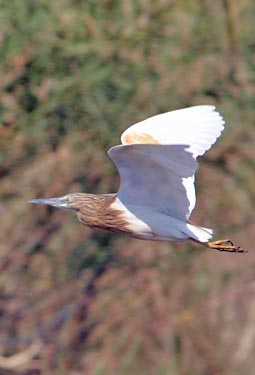
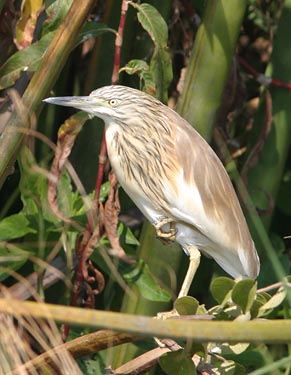 The
next set are six species of small herons in genus Ardeola: the
pond-herons. Four of the six are actually named "pond-heron" but Squacco Heron
(near left), widespread in the southern Palearctic and Africa, is not.
Both it, and the four pond-herons, show extensive white in the wings in
flight (far left; same bird in flight).
The
next set are six species of small herons in genus Ardeola: the
pond-herons. Four of the six are actually named "pond-heron" but Squacco Heron
(near left), widespread in the southern Palearctic and Africa, is not.
Both it, and the four pond-herons, show extensive white in the wings in
flight (far left; same bird in flight). 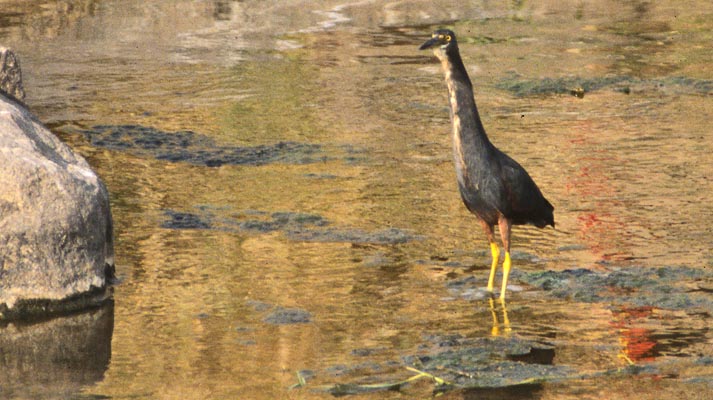
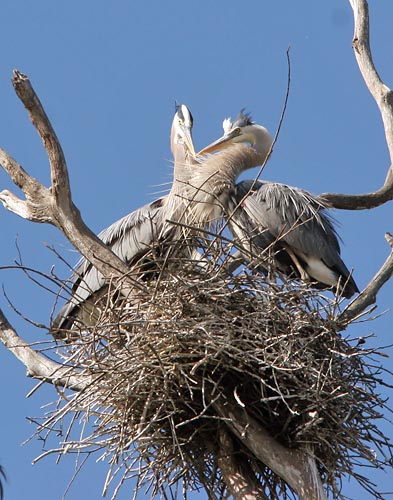 We finally come to the "day-herons," the large Ardea herons and the smaller Egretta
egrets, and some others, that can dominate marshland scenes. The sheer
abundance and variety of herons in swampy lowlands can be staggering.
Early morning or evening flights of herons in the Florida everglades or
Texas coast is a memorable spectacle, as are the seemingly unlimited
spread of herons, storks, and cormorants in the Brazilian Pantanal or
Venezuelan llanos. In those latter locales, Cocoi Heron (above) is a common species. Here, it has dramatically speared a fish.
We finally come to the "day-herons," the large Ardea herons and the smaller Egretta
egrets, and some others, that can dominate marshland scenes. The sheer
abundance and variety of herons in swampy lowlands can be staggering.
Early morning or evening flights of herons in the Florida everglades or
Texas coast is a memorable spectacle, as are the seemingly unlimited
spread of herons, storks, and cormorants in the Brazilian Pantanal or
Venezuelan llanos. In those latter locales, Cocoi Heron (above) is a common species. Here, it has dramatically speared a fish. 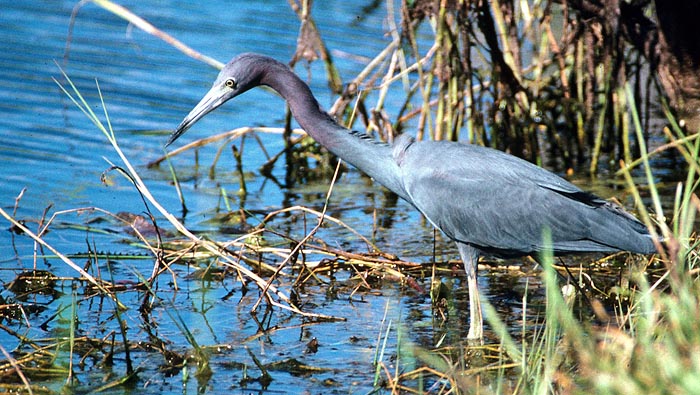 Most
of the large day-herons are "stand and wait" predators, including Great
Blue and Purple Herons, and Great Egret, and some smaller species such
as Little Blue Heron (right). Other herons feed by stirring up the
muddy bottom, jabbing at prey which is disturbed (Snowy & Little
Egrets), or by running in the shallow with half-open wings (Reddish
Egret Egretta rufescens), looking like a drunken sailor.
Most
of the large day-herons are "stand and wait" predators, including Great
Blue and Purple Herons, and Great Egret, and some smaller species such
as Little Blue Heron (right). Other herons feed by stirring up the
muddy bottom, jabbing at prey which is disturbed (Snowy & Little
Egrets), or by running in the shallow with half-open wings (Reddish
Egret Egretta rufescens), looking like a drunken sailor. 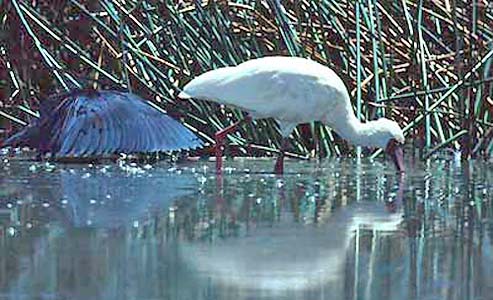
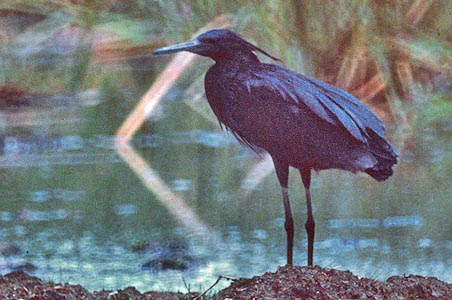
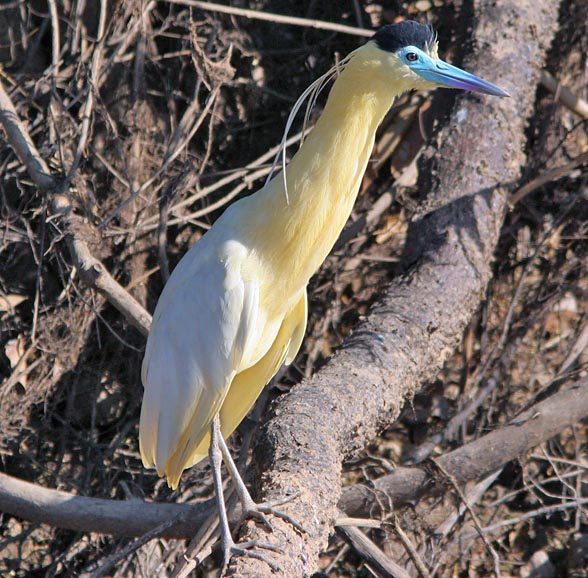 South America has two interesting and distinctive day-herons that are related to our final group. One is the very lovely Capped Heron
(left). I recall being totally astonished at its colorful blue face,
and its yellow-washed plumage, during my initial visit to the Amazon
Basin in 1975. This is a bird of forested swamps, usually near rivers.
On a later trip to the Brazilian Pantanal, we watched some interesting
behaviors between a mated pair.
South America has two interesting and distinctive day-herons that are related to our final group. One is the very lovely Capped Heron
(left). I recall being totally astonished at its colorful blue face,
and its yellow-washed plumage, during my initial visit to the Amazon
Basin in 1975. This is a bird of forested swamps, usually near rivers.
On a later trip to the Brazilian Pantanal, we watched some interesting
behaviors between a mated pair. 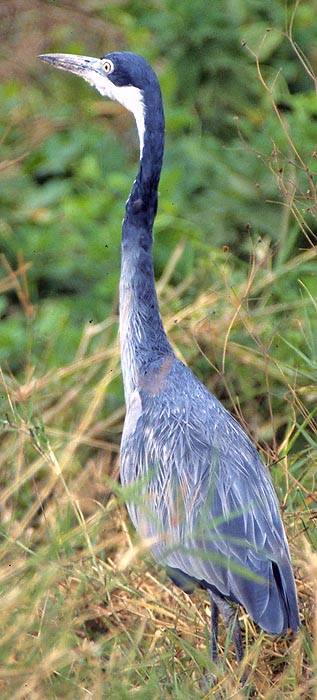 And yet there are still more herons and egrets to be discussed. A common and widespread species in sub-Saharan African is Black-headed Heron (right). There are places in New Guinea where the colorful Pied Heron (below) occurs in flocks.
And yet there are still more herons and egrets to be discussed. A common and widespread species in sub-Saharan African is Black-headed Heron (right). There are places in New Guinea where the colorful Pied Heron (below) occurs in flocks.
